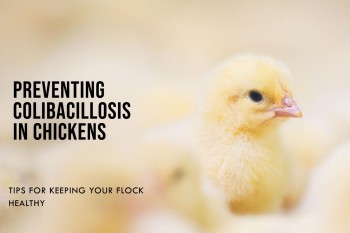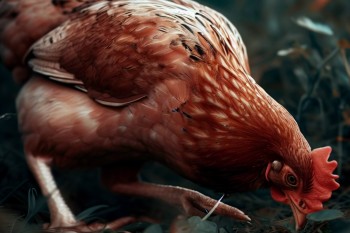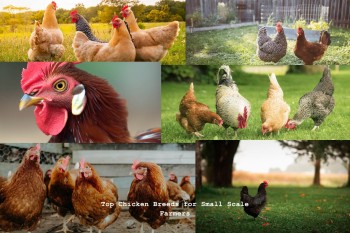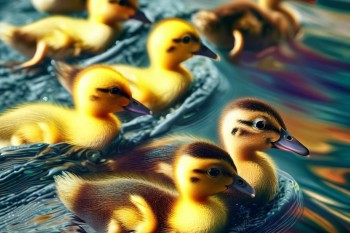Understanding Coccidiosis in Chickens: Causes, Symptoms, Treatment,
Prevention, and Management Best Practices 🐔
Tackling the Silent Threat
Greetings, poultry enthusiasts! Today, we dive into the
world of coccidiosis—a notorious disease that affects chickens worldwide,
causing significant mortality rates and hindering their growth and feed
conversion efficiency. 🌍🐥 Implementing
proper preventive measures and effective management practices are crucial in
combating this insidious poultry disease.
Unmasking the Culprits: Eimeria spp.
Coccidiosis is caused by various species of Eimeria, which
parasitize specific sections of the chicken's intestinal tract. These
microscopic parasites have a complex life cycle, with the infective stage being
the sporulated oocyst. If preventive measures aren't taken, infected and
recovered chickens shed oocysts, becoming a significant concern in multi-age
operations. Oocysts can be mechanically transmitted through clothing, footwear,
contaminated equipment, or even by wind, spreading poultry-house dust and
litter over short distances. 😷🌾
Factors Fueling Outbreaks: A Recipe for Disaster
Several factors contribute to the outbreak of clinical
coccidiosis in chicken flocks. These include:
1. Litter moisture content exceeding 30%, often caused by
rain or leaking waterers. High moisture levels create an ideal environment for
oocyst development and infectivity.
2. Immunosuppression resulting from diseases like Marek's
disease, infectious bursal disease (IBD), or mycotoxin contamination. Weakened
immune systems make chickens more susceptible to coccidial infection.
3. Suboptimal inclusion or incomplete distribution of
anticoccidials in feed, possibly due to poor mixing. Inadequate delivery of anticoccidial
drugs can lead to reduced efficacy against coccidial parasites.
4. Environmental and management stressors, such as
overstocking, malfunctioning feeding systems, and inadequate ventilation.
Stress weakens the birds' immune system and creates an environment conducive to
coccidial infection.
Recognizing the Signs
Coccidiosis typically manifests acutely and presents various
clinical signs in infected chickens. These signs include depression, ruffled
plumage, decreased activity, reduced feed intake, weight loss, and diarrhea.
Diarrhea may vary in consistency, ranging from loose to watery, and can be
bloody in severe cases. Chickens infected with Eimeria tenella may exhibit comb
and wattle pallor, along with blood-stained cecal droppings. Identifying these
signs early is crucial for timely intervention. 🚩🐓
Unveiling the Lesions: A Closer Look
Different species of Eimeria cause specific lesions within
the chicken's intestinal tract:
1. E. acervulina and E. mivati: These species primarily affect
the upper intestinal tract, including the distal duodenum and proximal jejunum.
Lesions appear as 1-2mm areas of hemorrhage interspersed with white foci,
visible through the serosa.
2. E. necatrix: This species primarily affects the
mid-jejunum. Severe distention of the mid-jejunum occurs, accompanied by
mucosal hemorrhages and the presence of red-stained fluid in the lumen.
3. E. maxima: The mid-jejunum is the primary site of
infection. Lesions include distention of the mid-jejunum and mucosal hemorrhages.
4. E. tenella: This species targets the ceca, causing
hemorrhagic typhlitis, which is inflammation of the cecal walls.
5. E. brunetti: Lesions are found in the distal jejunum and
colon, characterized by hemorrhages in the mucosa. In chronic cases,
fibrinonecrotic enteritis may occur.
Making the Diagnosis: Shedding Light on Coccidiosis
Gross lesions observed in E. tenella, E. necatrix, and E.
brunetti infections are usually sufficient for diagnosis. Microscopic
examination of intestinal and cecal scrapings can reveal the presence of
oocysts, further confirming the diagnosis. To obtain a definitive diagnosis in
commercial operations, specific specimens should be submitted to a laboratory
for analysis. These include:
• Intestine from a sacrificed, affected bird, preserved in
5% potassium dichromate for culture and identification of Eimeria species.
• Intestine showing gross lesions, preserved in 10% formalin
for histological examination.
• Representative feed samples for anticoccidial assay.
• Litter samples for oocyst counts.
Fighting Back: Treatment Options
When it comes to treating coccidiosis in chickens, prompt
action is crucial. Here are some treatment options to consider:
1. Amprolium solution: Administer at a concentration of
0.024% of the active ingredient in drinking water for 3 to 5 days. Amprolium
acts by inhibiting the reproduction of the coccidia, allowing the bird's immune
system to catch up and clear the infection.
2. Sulfonamides: Administer sulfamethazines at a
concentration of 0.1% for 2 days, followed by 0.05% for 4 days. Commercial
combinations of sulfa drugs can also be used in drinking water. Sulfonamides
work by suppressing the growth of the coccidia.
3. Water-dispersible vitamin A and K supplements: These
supplements can be administered to enhance recovery and support the bird's
overall health during the infection.
Prevention: Building Strong Defenses
Preventing coccidiosis requires a multi-faceted approach
that encompasses management practices and preventive measures. Here are some
strategies to consider:
1. Limiting litter saturation:
- Proper
installation and management of watering systems, such as nipple drinkers, to
reduce water spillage onto the litter. This helps maintain litter moisture at
appropriate levels.
- Ensuring an
acceptable ventilation rate to maintain optimal environmental conditions.
Proper ventilation reduces moisture buildup and promotes air quality.
- Maintaining
recommended stocking density to minimize stress and prevent overcrowding.
- Providing
adequate feeding space to avoid competition and stress during feeding.
2. Inclusion of anticoccidials in diets:
- Incorporate
anticoccidials at recommended levels to prevent clinical infections. Various
anticoccidial drugs are available, including ionophores and chemical
coccidiostats.
- Consider using
chemical and ionophoric anticoccidials in broilers as part of shuttle programs.
Shuttle programs involve alternating the use of different anticoccidials to
reduce the risk of coccidial resistance.
- Utilize synthetic
coccidiostats in breeders and floor-reared commercial egg production flocks to
promote premunity. Premunity refers to the development of immunity after
exposure to subclinical infections.
3. Anticoccidial vaccines:
- Vaccination is
suitable for replacement breeding stock and roasters. Anticoccidial vaccines
contain live attenuated or non-attenuated strains of Eimeria, stimulating an
immune response and conferring protection against subsequent infections.
- This approach can
be cost-effective but requires experienced management and diligent monitoring,
especially when administering the vaccine via feed or through intraocular
administration.
Effective Management Practices: Nurturing Healthy Flocks
In addition to preventive measures, implementing good
management practices is essential for controlling coccidiosis and maintaining
the overall health of your poultry flock. Consider the following practices:
1. Biosecurity: Implement
strict biosecurity measures to prevent the introduction of coccidial oocysts
into your farm. This includes controlling visitor access, disinfecting
equipment, and practicing proper hygiene protocols.
2. Cleanliness and Sanitation:
Maintain clean and dry litter conditions by regularly removing wet or soiled
litter and ensuring proper ventilation. Clean and disinfect equipment, feeders,
and waterers regularly to minimize the risk of coccidial transmission.
3. Feed Management: Ensure
the proper formulation and distribution of feed, including the appropriate
inclusion of anticoccidials. Follow recommended feeding programs and monitor
feed quality to provide optimal nutrition and support the bird's immune system.
4. Water Quality: Provide
clean and fresh water to your flock, ensuring it is free from contamination.
Regularly clean and disinfect water lines and waterers to prevent the
transmission of coccidial oocysts.
5. Vaccination Programs:
Work with your veterinarian to develop and implement an effective vaccination
program tailored to the specific needs of your flock. Follow vaccination
protocols carefully, ensuring proper storage, handling, and administration of
vaccines.
6. Monitoring and Surveillance:
Regularly monitor your flock for signs of coccidiosis and other diseases.
Implement a surveillance system to detect any early signs of infection,
allowing for timely intervention and treatment.
7. Record-Keeping: Maintain
detailed records of flock health, including vaccination history, treatments
administered, and any observed disease outbreaks. This information will help
you track trends, identify potential risk factors, and make informed management
decisions.
Guarding Our Flocks, Nurturing Our Poultry Industry
Coccidiosis poses a significant threat to poultry farms
worldwide, causing economic losses and impacting the overall well-being of our
feathered friends. By understanding the causes, recognizing the symptoms,
adopting appropriate treatment protocols, implementing preventive measures, and
maintaining effective management practices, we can effectively combat this
formidable poultry disease. Let's prioritize the health of our flocks, nurture
our poultry industry, and work together to keep our chickens thriving and
disease-free. 🐔🌾
Remember, a proactive and comprehensive approach to disease
prevention and management is key to sustaining a successful poultry operation.
Stay informed, consult with veterinarians, and follow recommended management
practices to ensure the well-being and productivity of your precious chickens. 🐤🚜


















